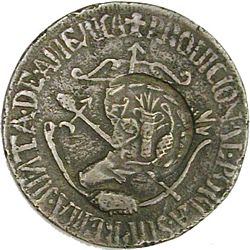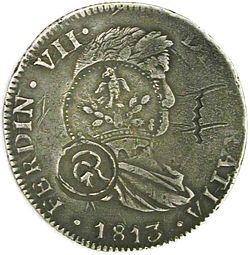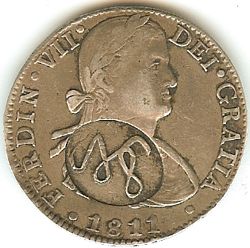Validation stamps of the War for Independence
by Max A. Keech
Introduction
The Mexican War for Independence coinage is one of the most fascinating, diverse and complex series in all of Latin American numismatics. This short series is rich in history and can provide a rewarding experience for collectors at all levels. Unfortunately, many otherwise interested collectors are discouraged by a lack of reliable information. With respect to validation stamps, they are also confronted with organizational difficulties in classifying the coinage and the large number of counterfeits in the marketplace. Let’s take a closer look at these issues and see if we can unravel some of their mysteries.
Prior to the start of the War for Independence in September of 1810, provincial capitals shipped bullion to Mexico City, which was coined and then returned. From late 1810 on, Insurgents controlled large parts of Mexico, effectively severing these local mining centers from the Royal Mint. Out of necessity, local authorities resorted to casting or striking provisional coinage for commerce and to pay the troops. Most branch mints started by either (1) striking a provisional coinage of local design or (2) casting coins from Mexico City hosts and then applying a validation stamp. Near the end of 1812 it appears that the authorities in Mexico City forbid the use of provisional designs. To comply, the branch mints of Durango, Guadalajara, Guanajuato and Zacatecas began coining the Ferdinand VII draped bust design. The rarity of all these draped bust issues dated 1812 attests to this timing. Chihuahua was the laggard, making the transition after 1813.
In 1811 Insurgent groups also began producing their own coinage for commerce. Coined silver was much more useful than silver bars for purchasing supplies or paying soldiers. Like the Royalists, the Insurgents both struck and cast necessity issues in silver, although casting was the more common method of Insurgent production. Both the Royalist and Insurgent necessity issues of this early period were crudely produced and of generally poor quality. Both weight and fineness could vary considerably.
Because of this poor quality, the local inhabitants, who for generations had been accustomed to the excellent Mexico City coinage with its reliable silver content, were reluctant to accept these necessity issues. This led Royalist and Insurgent authorities to counterstamp the necessity issues as official verification of their value.
There is only one substantive numismatic reference on the War for Independence series, Dr. Alberto F. Pradeau’s indispensable Numismatic History of MexicoA. F. Pradeau, Numismatic History of Mexico from the Pre-Columbian epoch to 1823. New York, 1938. Pradeau offers relevant background on most of the issuers but his book was published in 1938 and is in need of updating. Pradeau and later catalogues have tended to classify the coinage first as Royalist or Insurgent and then catalog it in alphabetical order. This alphabetical classification does not offer much insight into the series and is confusing in many areas. I believe an understanding of the geographical location and connected issuing authority of the validation stamps is necessary to structure and simplify the series.
Let’s look at this series by considering the purpose for an issue along with the interrelated geography, issuing authority and time. Before we do let’s start with three rules that I believe create the foundation for simplifying this complex series.
The rules we will examine are;
Rule#1: All validation stamps were used as either casting stamps or counterstamps and, with the exception of Morelos, never for both.
Rule#2: All validation stamps were applied between 1811 and 1814, and
Rule#3: Only provisional/necessity coinage was counterstamped.
I have deliberately used the term “validation” stamp in this introduction rather than the more common phrase of “counterstamp” or “countermark”. This is because the series comprises two distinctly different types of stamps and it is important to separate them by their purpose. For this we need a new term for stamps applied as part of the manufacturing process associated with cast coinage. I’m stuck between the choices of casting stamp and minting stamp so, for now, let’s refer to them as mint casting stamps. The important point is that we clearly subdivide the validation stamps into those associated with the manufacture of new coinage and those associated with validating coinage that already circulates.
“Mint casting stamps” versus “counterstamps”
In considering the purpose of a validation stamp we should draw a clear distinction between a “mint casting stamp” and a “counterstamp”.
 A “mint casting stamp” is applied as part of the manufacturing process of a coin. It is the final step taken after casting a provisional/necessity issue before releasing the coinage into circulation. Cast coinage was easily counterfeited by casting fakes of lower fineness or silver content. The addition of a mint casting stamp (and sometimes an edge) during manufacture discouraged cast counterfeits. Both Royalists (always) and Insurgents (often) utilized mint casting stamps in the process of manufacturing cast necessity coinage.
A “mint casting stamp” is applied as part of the manufacturing process of a coin. It is the final step taken after casting a provisional/necessity issue before releasing the coinage into circulation. Cast coinage was easily counterfeited by casting fakes of lower fineness or silver content. The addition of a mint casting stamp (and sometimes an edge) during manufacture discouraged cast counterfeits. Both Royalists (always) and Insurgents (often) utilized mint casting stamps in the process of manufacturing cast necessity coinage.
 A “counterstamp” is a stamp applied after manufacture to validate an already circulating provisional/necessity issue. It could be applied to a cast or struck coin but it was always applied to an already circulating coinage and not as a part of the manufacturing process
A “counterstamp” is a stamp applied after manufacture to validate an already circulating provisional/necessity issue. It could be applied to a cast or struck coin but it was always applied to an already circulating coinage and not as a part of the manufacturing process
This distinction helps us to identify the who, where and when of a particular issue. For a mint casting stamp you have a casting process and that requires some sort of foundry. Only in major towns and encampments were there foundries, generally used to cast armaments such as cannon and cannonballs etc, and it is in these locations that coinage was cast using mint casting stamps. On the other hand, counterstamps could occur anywhere it was necessary to validate a provisional issue for local use.
As with all coinage it is imperative to understand how a coin is manufactured to avoid counterfeits. A counterfeiter often does not adhere to the same manufacturing process as the original coinage and, in so doing, exposes his product to detection. For example, a mint casting stamp can only occur on a cast coin and since the cast and stamp were produced at the same time, each should show identical wear. Every one of the mint casting stamps and counterstamps of the War for Independence has been counterfeited so confirming the proper method of manufacture is step 1 in authenticating a coin.
With the exception of the Morelos stamps virtually none of the validation stamps were used as both a mint casting stamp and as a counterstamp. Therefore, excluding Morelos the “rule” is that a particular type of stamp is either a mint casting stamp or a counterstamp. It does not occur as both. The few (and very rare) exceptions are unlikely to be encountered by all but the most advanced collectors of these issues. Hence this “rule” provides the collector with a reliable way of determining what host coins and which stamps can legitimately occur together.
Rule#1: All validation stamps, with the exception of Morelos, were used as either casting stamps or counterstamps and never for both.
Validation Stamps used from 1811-1814 only
Another “rule” is that all mint casting stamps and counterstamps were applied between 1811 and early 1814. By 1814 the Royalist army had subdued and scattered the Insurgents. The Insurgents no longer controlled any population centers and with no significant territory under their control no longer produced or counterstamped coinage. The last Insurgent necessity coinage occurred in 1814 and both Supreme Junta and Morelos issues of this date are quite scarce. By this time the provisional Royalist mints had improved their coinage processes and, as previously mentioned, were issuing the standardized Ferdinand VII draped bust design. To my knowledge no Insurgent counterstamps or mint casting stamps occur after 1813 and the few Royalist issues of 1814 are quite rare. This leads to our next rule:
Rule#2: All mint casting stamps and counterstamps occur on 1814 and earlier coinage.
When you encounter a mint validation stamp on a post 1814 host, you either have (i) a coin struck over an 1811-1814 validation stamp or (ii) a counterfeit.
Only provisional/necessity coinage was counterstamped
As previously mentioned, counterstamps were used to validate coinage already in circulation for use within an authority’s jurisdiction. The early necessity issues were not of the standard draped bust type and they were not trusted by the population that was accustomed to high quality Mexico City mint coinage for generations. These early provisional issues (both cast and struck) were crude and clearly not a struck and trusted Mexico City coinage. It is these necessity/provisional issues that required validation. If the host coin appears to you like proper Mexico City struck coinage, it would have looked that way in 1814 and there would be no reason to validate it. I have never seen evidence that good Mexico City coinage was overstruck to “mark territory”, “fly the flag” or any similar secondary purpose. While there are a few (very rare) exceptions to this “rule”, non-experts should stay away from counterstamps on struck Mexico City issues.
Rule#3: Counterstamps were only used on provisional/necessity coinage and not on struck Mexico City coins.
 I can almost hear a reader or two whispering “what about the famous counterstamps of Manuel Salcedo, Governor of Texas and the subject of numerous articles?” The full explanation of these fantasy issues demands an article unto itself but suffice to say that in this author’s opinion these are all imaginary fantasies. I base this claim on what I believe is overwhelming evidence offered by the coins themselves and not just their violation of rules #1 and #3 above. Stay tuned…..
I can almost hear a reader or two whispering “what about the famous counterstamps of Manuel Salcedo, Governor of Texas and the subject of numerous articles?” The full explanation of these fantasy issues demands an article unto itself but suffice to say that in this author’s opinion these are all imaginary fantasies. I base this claim on what I believe is overwhelming evidence offered by the coins themselves and not just their violation of rules #1 and #3 above. Stay tuned…..
Cataloging challenges
The primary reference for most collectors is the Krause catalog and in the case of War for Independence validation stamps it is quite confusing and in many cases incorrect. In general it classifies Royalist mint casting stamps as non-countermarked provisional mint coinage while listing Insurgent mint casting stamps as counterstamps. It mistakenly lists a number of post-1814 counterstamps and counterstamps on struck Mexico City coins, along with a few counterfeits, as genuine issues. Auction catalogs of Mexican specialists such as Ponterio, Long, Douglas and Hidalgo do a better job of identifying this series but they are all handicapped by the same underlying reference problems.
If you follow the three rules above (all non-Morelos stamps can be classified as mint casting stamps or counterstamps and were only struck on provisional/necessity issues from 1811-1814), you can quickly overcome the cataloging challenges. We’ll now take a quick survey of the most often encountered Royalist and Insurgent issues along with a few rare issues of special interest. I think you will find that the Royalist issues are straightforward while the Insurgent series is more complex and challenging.
